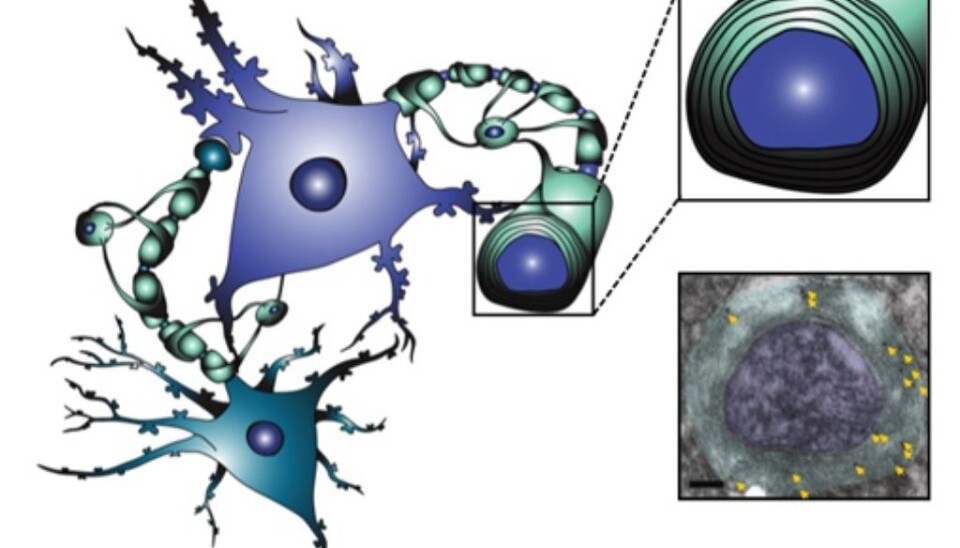An article from University of Oslo

New research may change how MS is diagnosed
What doctors believed to mark nerve cell death may instead show reparable injury in patients with multiple sclerosis.
Denne artikkelen er over ti år gammel og kan inneholde utdatert informasjon.
When doctors localize nerve cells on MRI, they look for nerve cell markers. These are visible substances found only in nerve cells that tell them where the nerve cell is and if it is alive. In diseases where the immune system attacks the insulating substance around the nerve cell, doctors use a nerve cell marker called NAA to assess whether the nerve cell is damaged or killed by the attack.
New findings show that NAA is also found in large quantities in the insulating substance. This means that a reduction in NAA does not necessarily indicate damage to the nerve cell.
The finding has implications for how doctors interpret MRI images when examining and diagnosing MS patients. It provides hope that the symptoms caused by an attack on the insulating substance may be reversible, also when the NAA cell marker is reduced on MRI.
Better knowledge of how the insulating substance is formed will contribute to improved drugs for diseases that affect the insulating substance around the nerve cells.
Not necessarily nerve cell death in MS

“MS is an example of where we can see a pronounced reduction in the nerve cell marker NAA in areas where the insulating substance is attacked,” explains Kaja Nordengen of the Institute of Basic Medical Sciences at the University of Oslo.
“In cases where NAA is reduced on MRI images, we had thought that the attack on the insulating substance was so severe that the nerve cells had also died,” explains Nordengen.
The insulating substance can be regenerated, nerve cells cannot.
The findings of Nordengen and the research group, however, indicate that NAA is not purely a nerve cell marker, as NAA is also found in large quantities in the insulating substance around the nerve cells.
“NAA is an important marker for disease of the brain, but our findings show that it is incorrect to use NAA purely as a nerve cell marker. Especially with MS, it is important not to interpret reduction in NAA as irreversible nerve cell death, as there may be reversible damage to the insulating substance,” says Nordengen.
Surprising finding
The researchers made the discovery while attempting to work out where in the nerve cell NAA was located, and whether it could function as a signalling substance (neurotransmitter) between the nerve cells.
“We have previously demonstrated that non-acetylated aspartate functions as a signal substance between nerve cells, and we therefore wondered whether the acetylated version (NAA) could also do this,” says Nordengen.
In addition to localising NAA in the nerve cell, they unexpectedly discovered that NAA is found not just here, but also in the cells that form the insulating substance. This had to mean that NAA should not be interpreted purely as a nerve cell marker. It is now almost five years since the initial findings, and since then the research group has spent their time finding out whether this could really be correct:
“All the experiments we have done since then have been to verify the finding,” says Nordengen.
“It was, quite simply, so surprising that we had problems believing it ourselves.”
The findings may turn our study of MS and other diseases that affect the insulating substance around nerve cells on its head.
Important for formation of the insulating substance
As part of their testing of the initial findings, Nordengen and her collaborators have conducted research on Canavan disease. This is a genetic disease that also affects the insulating substance. Children born with this disease rarely live beyond the age of four years.
Canavan disease is the only disease of the brain in which an increase in NAA can be seen on MRI images. The researchers had previously thought that it was the high level of NAA that had destroyed the insulating substance, and this was what Nordengen and her collaborators wanted to check.
“We kept brain slices alive in the laboratory for several weeks while we added high doses of NAA. Then we studied the insulating substance, the cells that form this, and nerve cells in a confocal microscope,” Nordengen tells us.
In contrast to previous assumptions, they found that both the cells and the insulating substance remained undamaged. This reinforces the theory that NAA is important for the formation of the insulating substance.
Towards an effective treatment
The analyses of NAA are performed using an electron microscope. Here antibodies connected to a tiny gold particle measuring 10 nanometres in diameter were added to the brain slices. The antibodies with gold particles attach themselves to the NAA antibodies and make then visible as small black dots. The most time-consuming job has been to count the dots, as Nordengen tells us:
“To obtain a quantitative measure of NAA, I have counted these in different structures, different animals and different areas of the brain. For this project alone, I have counted more than 10,000 structures!”
This meticulous work has yielded significant results, but Nordengen points out that as yet we have no treatment for diseases that affect the insulating substance in the brain.
“We hope nevertheless that increased knowledge about how the insulating substance is formed will contribute to the discovery of drugs for MS and similar diseases in the future,” she says, and adds that, together with group leader Vidar Gundersen, she is planning a project that combines basic and clinical research on neurological diseases.
------------
Read the Norwegian version of this article at forskning.no




































